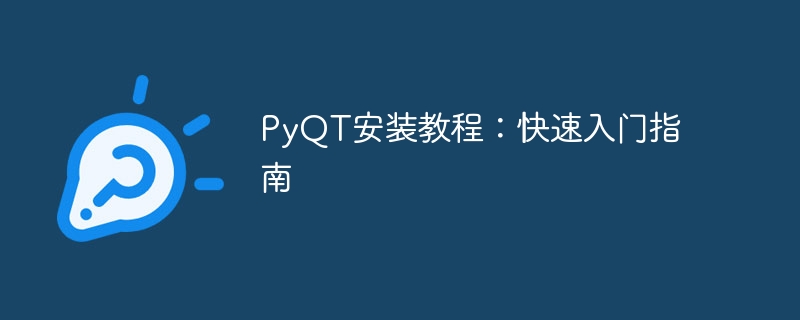

PyQT Installation Tutorial: Quick Start Guide
PyQT is a powerful Python interface development library that can be used to create various user interface applications. This article will provide you with PyQT installation tutorial and quick start guide, and provide specific code examples to help you get started quickly.
Step 1: Install PyQT
To install PyQT, you need to install Python first. It is recommended to use Python 3.x version. You can download and install the Python version suitable for your operating system from the official Python website (https://www.python.org/downloads/).
After installing Python, open a command prompt (Windows users) or terminal (Mac and Linux users) and enter the following command to install PyQT:
pip install pyqt5
This will download the file from PyPI (Python Package Index) ) to download and install the PyQT library and its related dependencies.
Step 2: Write the first PyQT program
After the installation is complete, let’s write a simple PyQT program. Create a new file, name it "main.py", and enter the following code in the file:
import sys
from PyQt5.QtWidgets import QApplication, QMainWindow, QLabel
# 创建应用程序对象
app = QApplication(sys.argv)
# 创建主窗口
window = QMainWindow()
# 添加标签组件到主窗口
label = QLabel("Hello, PyQT!")
window.setCentralWidget(label)
# 显示主窗口
window.show()
# 运行应用程序
sys.exit(app.exec_())In this code, we first introduce the necessary libraries and classes. Then an application object (QApplication) and a main window object (QMainWindow) are created. Next, we added a label component (QLabel) to the main window and set the text displayed by the label. Finally, we display the main window and run the application.
Step 3: Run the PyQT program
After saving the file, open the command prompt (Windows users) or terminal (Mac and Linux users), enter the directory where the file is saved, and enter the following command to run Program:
python main.py
If all goes well, you will see a window pop up with the text "Hello, PyQT!"
Further learning
The above examples are just the tip of the iceberg of PyQT. PyQT also has many powerful functions and components that allow you to create more complex and rich user interface applications.
You can use PyQT's documentation to learn more about PyQT and usage. PyQT's official documentation (https://doc.qt.io/qtforpython/) provides detailed tutorials and reference materials, and provides a large number of sample codes to help you better understand and use PyQT.
In addition, PyQT’s official website (https://www.riverbankcomputing.com/software/pyqt/) also provides some useful resources and tutorials.
Summary
This article provides an installation tutorial and quick start guide for PyQT, and provides a simple PyQT program example. I hope this article can help readers get started with PyQT quickly and quickly master the basic usage of PyQT. Continue to learn and explore more functions of PyQT, which can bring great help to your interface development work.
The above is the detailed content of PyQT Installation Tutorial: Quick Start Guide. For more information, please follow other related articles on the PHP Chinese website!
 What is the use of docker image?
What is the use of docker image?
 How to find the location of a lost Huawei phone
How to find the location of a lost Huawei phone
 Clean the registry
Clean the registry
 How to set offline status on Douyin
How to set offline status on Douyin
 Oracle view table operation history
Oracle view table operation history
 Introduction to carriage return and line feed characters in java
Introduction to carriage return and line feed characters in java
 parseint function usage
parseint function usage
 What should I do if the docker container cannot access the external network?
What should I do if the docker container cannot access the external network?